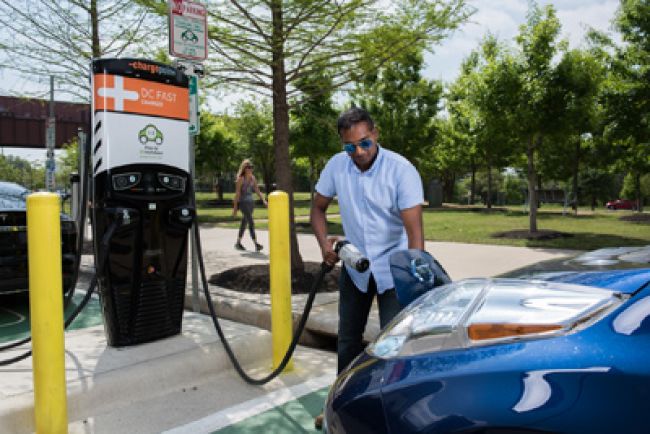
What’s Accelerating Electric Vehicle Growth?
It wasn’t long ago that relatively low fuel prices put the brakes on momentum for alternative fuels. But electric vehicles (EVs) appear to be defying that trend, even as conventional fuel prices remain low.
Consider the recent headlines. Norway intends to ban the sale of new diesel- and gas-powered cars and trucks in favor of EVs by 2025. China is planning to follow suit by 2030, with France and the U.K. each setting their targets for 2040. And, as of press time, the state of California is considering its own ban on non-EVs, which could have a huge ripple effect throughout the U.S. market.
Then there are major automakers – beyond Tesla – pushing the pace toward electrification. In October, General Motors announced that it’s pursuing an “all-electric future,” with 20 new fully electric models to be launched by 2023. Volvo, Aston Martin and Land Rover have introduced similar plans.
And according to a recent report by Bloomberg New Energy Finance, EVs could represent the majority – 54 percent – of new car sales by 2040.
So, what’s driving this momentum toward EVs? Here are three factors.
1. Battery cost continues to drop, while range increases.
The battery is the primary contributor to the price premium of EVs, but that’s starting to change – fast.
According to Bloomberg’s latest New Energy Finance report, lithium-ion battery prices have fallen 73 percent per kilowatt-hour since 2010, with that trend expected to continue until EVs become cheaper to buy than their fossil-fuel-powered counterparts by 2025 to 2029.
Lisa Jerram, principal research analyst with Navigant Research (www.navigantresearch.com), predicts a similar time frame. “As battery prices continue to drop, you get to a point – about 2024 – where some electric vehicle models become cost competitive with internal combustion engine cars without the [government] subsidies. And when you then factor in how much cheaper EVs are to run, you’ll really see this market taking off.”
As batteries drop in price, they also need to last longer for mainstream buyers to embrace EVs. Recent developments are making this possible, said Karl Popham, the head of emerging technologies and electric vehicles at Austin Energy (https://austinenergy.com), the nation’s eighth-largest publicly owned electric utility.
“We’re not only seeing major advancements in lithium-ion technology, we’re also starting to see some real disrupters in the market – a new chemistry, a new technology that could offer four times the [energy] density, really increasing the range,” Popham said. “We could see battery ranges of 400 to 500 miles in the not-too-distant future.”
2. EV charging infrastructure is readily available.
Why does electrification appear to be gaining traction in an era of low fuel prices, while other green fuel technologies, like compressed natural gas and propane autogas, seem to be hitting some resistance?
The answer lies in the wider availability and significantly lower cost of the “fueling” infrastructure, according to Popham.
“The fueling infrastructure for EVs is already there,” he said. “With those other fuels, it can be very expensive to build a sufficient number of fueling stations to adequately serve the market. But with EVs, drivers can simply plug into an existing standard electrical outlet, something over half of the cars in our territory do today to meet the majority of their charging needs.”
What about consumer resistance to changing behavior when it comes to remembering to charge their vehicles?
“Typically, I don’t hear a lot of complaints on plugging in,” Popham said. “Once they buy a car, it’s more like remembering to charge their cellphone. And even though in Austin we have over 600 Level 2 charging ports and growing, over 85 percent of EV charging is still done at home, behind their existing meter.”
3. Electrification is expanding into the truck segment.
One of the challenges of electrifying this segment has been that trucks typically require bigger, more powerful batteries, putting the price tag out of reach for most consumer and fleet buyers alike. But now, as battery range improves and costs continue to drop, a growing number of OEMs and third-party companies have begun offering more affordable electric-drive systems for trucks.
Consider these developments from just the past few months.
- In May, Workhorse (http://workhorse.com/pickup/) unveiled its plug-in electric W-15 pickup that’s expected to be available in 2018.
- In August, Chanje Energy (www.chanje.us), a Los Angeles-based manufacturer of electric commercial vehicles, unveiled its new electric delivery van that, as of press time, is expected to be available by the end of 2017.
- In September, Boston-based XL Hybrids (www.xlhybrids.com) introduced the first-ever hybrid-electric upfit for Ford F-250 pickups and chassis for commercial fleets.
- At the Tokyo Motor Show in October, Daimler Trucks (www.daimler.com) unveiled its all-electric heavy-duty E-FUSO Vision One with a range of up to 350 kilometers (217 miles).
- Tesla (www.tesla.com) CEO Elon Musk said the automaker will introduce its all-electric semitruck before the end of the year.
The Bottom Line
Momentum is building for EVs, which will give you more electrified options to consider for your fleet in the coming months and years, so continue to watch this space.

